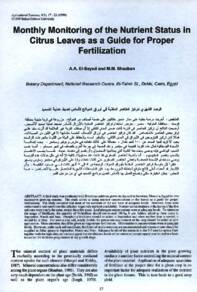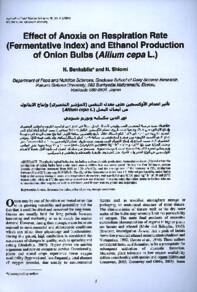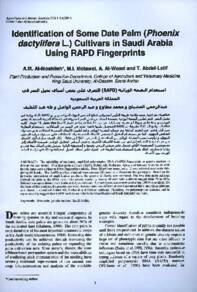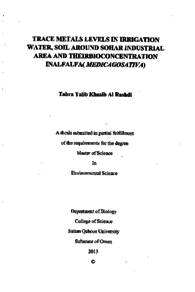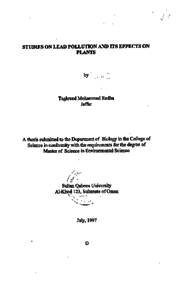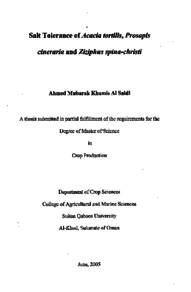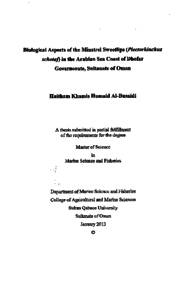Document
Monthly monitoring of the nutrient status in citrus leaves as a guide for proper fertilization.
Contributors
Shaaban, M. M., Author
Publisher
Sultan Qaboos university
Gregorian
1999
Language
English
English abstract
A field study was conducted with five citrus cultivars grown in clay soil in Kewesna, Monufia, Egypt for two successive growing seasons. The study aimed at using nutrient concentrations in the leaves as a guide for proper fertilization. The study revealed that most of the nutrients in the soil were at adequate levels. However, there were unfavourable soil conditions that affected negatively nutrient availability. Nutrient concentrations in the leaves of the five cultivars were nearly the same, except for a few cases. Leaf nitrogen concentrations were at adequate levels. To minimize the usage of fertilizers, the quantity of N-fertilizer should not exceed 100 kg N per feddan, added as three doses in September, March and June. Phosphorus fertilızers should be added in September and when another dose is needed, it should be in May. For such a clay soil, nearly double the potassium requirement of the crop should be added as split application. More attention should be given to magnesium fertilization Micronutrients concentrations were at adequate levels. However, under such soil conditions, fertilizers of acidic reactions are recommended and micronutrients should be supplied as foliar sprays in September, March and May. Adequate levels of the nutrients in the 5-7 months spring flush together with the high obtained yields suggest that the obtained levels of the nutrients (except copper) can be used as a basis to correct the fertilizer programmes at any growth stage.
Member of
ISSN
2410-1079
Resource URL
Citation
ElSayed, A. A., & Shaaban, M. M.(1999). Monthly monitoring of the nutrient status in citrus leaves as a guide for proper fertilization. Journal of Agricultural and Marian Sciences, 4 (1), 17-22.
Arabic abstract
أجريت دراسة حقلية على مدار عامين متتاليين على خمسة أصناف من الموالح، مزروعة في تربة طينية بمنطقة قويسنا - محافظة المنوفية- مصر، بغرض استخدام تركيز العناصر المغذية بالأوراق كأساس لضبط عملية تسميد الأشجار. أوضحت النتائج أن تركيز العناصر في التربة كانت ضمن المدى الكافي إلا أن صفات التربة غير الملائمة قد أثرت سلبا على توفر بعض العناصر للامتصاص. لقد كان تركيز العناصر في أوراق الأصناف الخمسة متشابهة إلا في القليل من الحالات. فمثلا كان تركيز النيتروجين في الأوراق في المدى الكافي، ولتوفير السماد وللحفاظ على البيئة من التلوث بالجرعات الزائدة يجب ألا تزيد كمية السماد عن 100 كجم للفدان، مضافة على ثلاث دفعات في مارس ويونيو وسبتمبر، يجب إضافة الأسمدة الفوسفاتية لمثل هذه التربة الطينية في سبتمبر وعند الحاجة إلى جرعة أخرى فتضاف في شهر مايو. أما عند التسميد البوتاسي فإنه يوصى بمضاعفة الكمية التي يحتاجها المحمول وأن تقسم إلى دفعات عديدة. كما يجب الاهتمام بالتسميد بعنصر المغنيسيوم. أما بالنسبة للعناصر الصغرى فقد كانت عند مستويات كافية إلا أنه في مثل حالات هذه التربة يوصى باستخدام الأسمدة الحمضية وتعطى العناصر الصغرى على ثلاث دفعات رشا على الأوراق في سبتمبر ومارس ومايو، نظرا لأن متوسط تركيز العناصر المغذية بأوراق النموات الربيعية من 5 إلى 7 أشهر كانت في حدود الكفاية، وأن الأشجار قد أعطت أعلى إنتاج متوقع للمنطقة المزروعة بها، فإن المتوسطات الشهرية المتحصل عليها للعناصر - عدا النحاس - يمكن اعتبارها مثلى وتصلح للعمل بها كأساس لتعديل برنامج التسميد في أي من مراحل النمو.
Category
Journal articles

